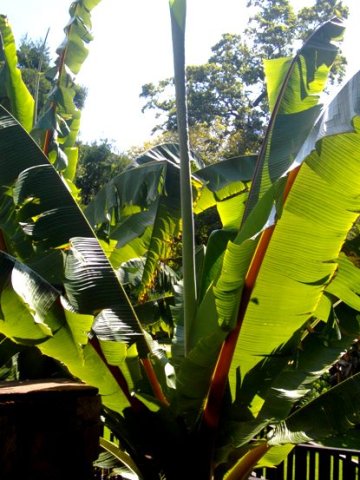Ensete ventricosum leaves

Author: Ivan Lätti
Photographer: Thabo Maphisa
The large, spirally arranged, simple leaves of Ensete ventricosum resemble those of banana plants. They may become up to 2,5 m long and 1 m wide. The leaves are hairless and bright green with conspicuous, thick, rose-pink midribs.
Numerous parallel nerves can be seen extending straight to the margins, forming slight ridges upon the leaf blades. The leaf blades reach down almost to the leaf base that runs into the stem; the petiole being very short.
The upright flagpole-like central leaf in the photo will soon unfurl its broad lateral blades from the midrib. Wind tears horizontal sections of the leaves apart, although not from the midrib.
While food in Ethiopia is mainly obtained from stems and roots, plant parts are also eaten further south in the plant’s distribution area: The leaves are cut into small pieces and cooked, tasting like celery. Also young inflorescences are cooked as a vegetable.
E. ventricosum is successfully grown from seed in gardens that are relatively frost-free. When well-watered, it grows fast and tall, but succumbs after its one-off fruiting (Coates Palgrave, 2002; Wikipedia; Van Wyk and Van Wyk, 1997; Fox and Young, 1982).

